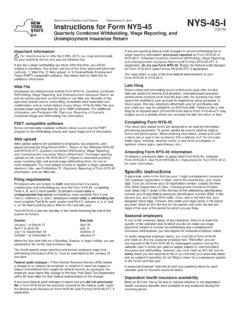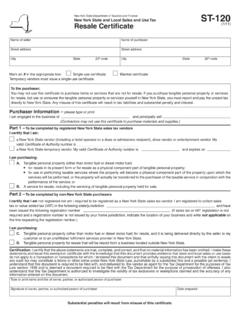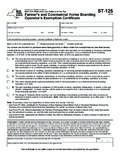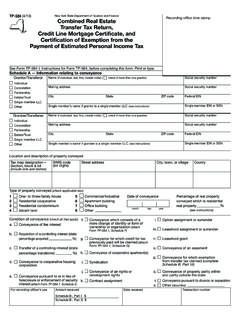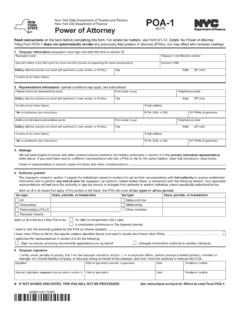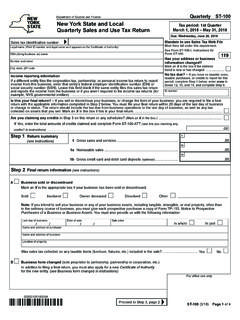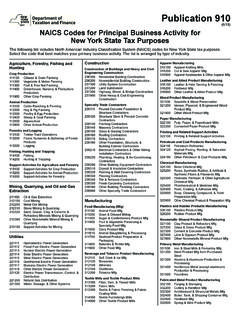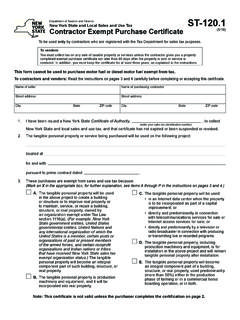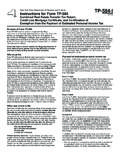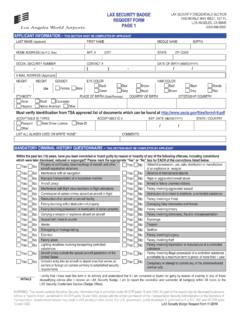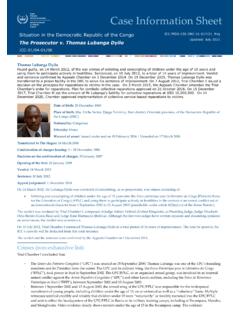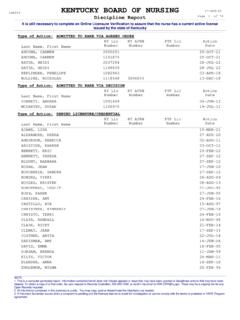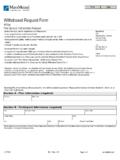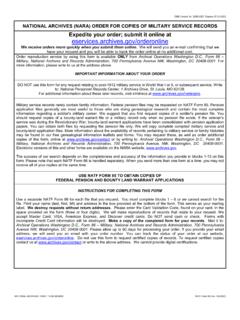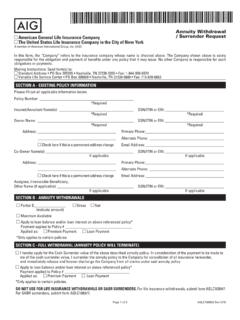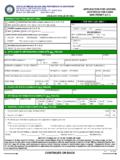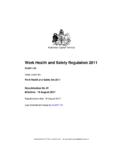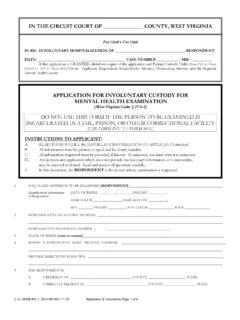Transcription of Table of contents - Government of New York
1 Department of Taxation and Finance Instructions for Form CT-3 General Business Corporation Franchise Tax ReturnCT-3-ITable of contents PageForm CT-1, Supplement to Corporation Tax Instructions .. 2 Corporate tax filing requirements .. 2 Corporations subject to tax under Article 9-A .. 2 Other forms you may need to file .. 4 When to 5 Where to file .. 5 Penalties and interest .. 5 voluntary Disclosure and Compliance Program .. 6Is this an amended return? .. 6 Filing your final return .. 7 New york S corporation termination year .. 7 Overview of corporation franchise tax .. 7 Tax bases .. 7 New york State innovation hot spot program .. 7 Tax on business income .. 7 Tax on business capital .. 7 Fixed dollar minimum 7 Computation of tax for corporate partners .. 7 Corporate partners required to file under the aggregate method .. 7 Tax rates 9 Foreign airlines .. 10 How to fill out your tax return (Important identifying information and Signature).
2 10 Line 10 Part 1 General corporate information .. 11 Part 2 Computation of balance due or overpayment .. 13 Part 3 Computation of tax on business income base .. 14 Part 4 Computation of tax on capital 16 Part 5 Computation of investment capital for the current tax year .. 16 Part 6 Computation of business apportionment factor .. 16 Worksheet A Gross proceeds factors and net gains for lines 10, 12, 21, and 24 .. 25 Worksheet B Net gains and other income for line 30 .. 26 Worksheet C Marked to market (MTM) net gains for line 28 .. 27 Part 7 Summary of tax credits claimed .. 30 Page 2 of 30 CT-3-I (2021)Form CT-1, Supplement to Corporation Tax InstructionsSee Form CT-1 for the following topics: Changes for the current tax year (general and by Tax Law Article) Business information (how to enter and update) Entry formats Dates Negative amounts Percentages Whole dollar amounts Are you claiming an overpayment? NAICS business code number and NYS principal business activity Limitation on tax credit eligibility Third-party designee Paid preparer identification numbers Is your return in processible form?
3 Use of reproduced and computerized forms Electronic filing and electronic payment mandate Online services Web File Form CT-200-V Collection of debts from your refund or overpayment Fee for payments returned by banks Reporting requirements for tax shelters Tax shelter penalties voluntary Disclosure and Compliance Program Your rights under the Tax Law Need help? Privacy notificationCorporate tax filing requirementsAll New york C corporations subject to tax under Tax Law Article 9-A must file using the following returns, as applicable: Form CT-3, General Business Corporation Franchise Tax Return Form CT-3-A, General Business Corporation Combined Franchise Tax Return Form CT-3-M, General Business Corporation MTA Surcharge ReturnAny return filed on an incorrect form, or on a form for the wrong year, except as described below, will not be processed and will not be considered timely filed. As a result, penalties and interest may be Form CT-3-A-I, Instructions for Form CT-3-A, for information as to when a combined return is permitted or this tax return for calendar year 2021, fiscal years that begin in 2021 and end in 2022, and tax years of less than 12 months that begin on or after January 1, 2021, but before January 1, can also use the 2021 return if.
4 You have a tax year of less than 12 months that begins and ends in 2022, and the 2022 return is not yet available at the time you are required to file the this case you must show your 2022 tax year on the 2021 return and take into account any tax law changes that are effective for tax years beginning after December 31, information on voluntary dissolution and surrender of authority, see Instructions for voluntary dissolution of a New york corporation (TR-125), and Instructions for surrender of authority by foreign business corporation (TR-199), on our using a 52-53 week year A taxpayer who reports on the basis of a 52-53 week accounting period for federal income tax purposes may report on the same basis for Article 9-A purposes. If a 52-53 week accounting period begins within seven days from the first day of any calendar month, the tax year is deemed to begin on the first day of that calendar month. If a 52-53 week accounting period ends within seven days from the last day of any calendar month, the tax period will be deemed to end on the last day of the calendar subject to tax under Article 9-AThe definition of a corporation, as used in Article 9-A and in these instructions, includes associations, limited liability companies (LLCs), limited liability partnerships (LLPs), and publicly traded partnerships that are taxed as corporations under the Internal Revenue Code (IRC).
5 For more information , see business corporation subject to tax under Article 9-A includes all corporations except: insurance corporations (including for-profit HMOs required to obtain a certificate of authority under Public Health Law Article 44) (Tax Law Article 33); transportation and transmission corporations (other than aviation corporations, corporations principally engaged in transportation, transmission, or distribution of gas, electricity, or steam (TTD corporations), and nonelecting railroad and trucking corporations) (Tax Law Article 9); farmers, fruit growers, and similar agricultural cooperatives with, or without, capital stock ( ); nonstock, not-for-profit corporations, no part of the net earnings of which inures to the benefit of any officer, director, or member; continuing 186 taxpayers (Article 9).Domestic corporations A domestic corporation (incorporated in New york State) subject to tax under Article 9-A is generally liable for franchise taxes for each fiscal or calendar year, or part thereof, during which it is incorporated until it is formally dissolved with the Department of State.
6 However, a domestic corporation that is no longer doing business, employing capital, owning or leasing property, or deriving receipts from activity, in New york State is exempt from the fixed dollar minimum tax for years following its final tax year and is not required to file a franchise tax return provided it meets the requirements listed in corporations A foreign corporation (incorporated outside of New york State) is liable for franchise taxes under Article 9-A during the period in which it is doing business, employing capital, owning or leasing property, maintaining an office, or deriving receipts from activity, in New york corporation is considered to be deriving receipts in this state if it has receipts within New york of $1 million or more in a tax year ( ). Receipts means the receipts that are subject to the apportionment rules in 210-A, and the term receipts within All citations are to New york State Tax Law sections unless specifically noted (2021) Page 3 of 30this state means the receipts included in the numerator of the apportionment factor determined under 210-A.
7 Also, receipts from processing credit card transactions for merchants include merchant discount fees received by the corporation ( (b)).A corporation is doing business in this state if ( (c)): it has issued credit cards (including bank, credit, travel, and entertainment cards) to 1,000 or more customers who have a mailing address in this state as of the last day of its tax year; it has merchant customer contracts with merchants and the total number of locations covered by those contracts equals 1,000 or more locations in this state to whom the corporation remitted payments for credit card transactions during the tax year; or the sum of the number of customers and the number of locations equals 1,000 or foreign corporation that is a partner in a partnership should see Corporate foreign corporation shall not be deemed to be doing business, employing capital, owning or leasing property, maintaining an office, or deriving receipts from activity, in this state by reason of ( ): the maintenance of cash balances with banks or trust companies in this state.
8 The ownership of shares of stock or securities kept in this state if kept in a safe deposit box, safe, vault, or other receptacle rented for the purpose, or if pledged as collateral security, or if deposited with one or more banks or trust companies, or with brokers who are members of a recognized security exchange, in safekeeping or custody accounts; the taking of any action by any such bank or trust company or broker, which is incidental to the rendering of safekeeping or custodian service to the corporation; the maintenance of an office in this state by one or more officers or directors of the corporation who are not employees of the corporation if the corporation otherwise is not doing business in this state, and does not employ capital or own or lease property in this state; the keeping of books or records of a corporation in this state if such books and records are not kept by employees of the corporation and the corporation does not otherwise do business, employ capital, own or lease property, or maintain an office in this state; or any combination of the activities listed business corporations subject to tax under Article 9-A, other than New york S corporations, must file franchise tax returns using Form CT-3, unless such corporations are required or permitted to file as members of a combined group (see Form CT-3-A).
9 A business corporation that has elected to be treated as a New york S corporation by filing Form CT-6, Election by a Federal S Corporation to be Treated as a New york S Corporation, must file Form CT-3-S, New york S Corporation Franchise Tax Return, instead of Form subchapter S subsidiary (QSSS) The filing requirements for a QSSS that is owned by a federal S corporation that is a New york C corporation or a nontaxpayer corporation are outlined below. In those instances where New york State follows federal QSSS treatment: the QSSS is not considered a subsidiary of the parent corporation; the QSSS is ignored as a separate taxable entity, and the assets, liabilities, income, and deductions of the QSSS are included with the assets, liabilities, income, and deductions of the parent for franchise tax purposes; and for other taxes, such as sales and excise taxes, the QSSS continues to be recognized as a separate the situations outlined below where the federal QSSS treatment is followed for NYS, the combined reporting rules are applied to determine if the parent (with its QSSS s activity included) files a Form CT-3, or files as a member of a combined group on a Form CT-3-A.
10 In the situations outlined below where the federal QSSS treatment is not followed, the combined reporting rules must still be applied to determine if either the parent, the QSSS, or both should file as distinct members of a combined group on a Form CT-3-A. Parent is a New york C corporation New york State follows the federal QSSS treatment if: 1) the QSSS is a New york State taxpayer; or 2) the QSSS is not a New york State taxpayer but the parent makes a QSSS inclusion election. In both cases, the parent (with its QSSS s activity included) files as a New york C corporation on a Form CT-3 or, if the combined filing requirements are met with one or more entities (other than the QSSS), on a Form CT-3-A. If the parent does not make a QSSS inclusion election when the QSSS is not a New york State taxpayer, the parent (without its QSSS s activity included) files as a New york C corporation on a Form CT-3 or, if the combined filing requirements are met with one or more other entities (one of which could be the QSSS), on a Form CT-3-A.
